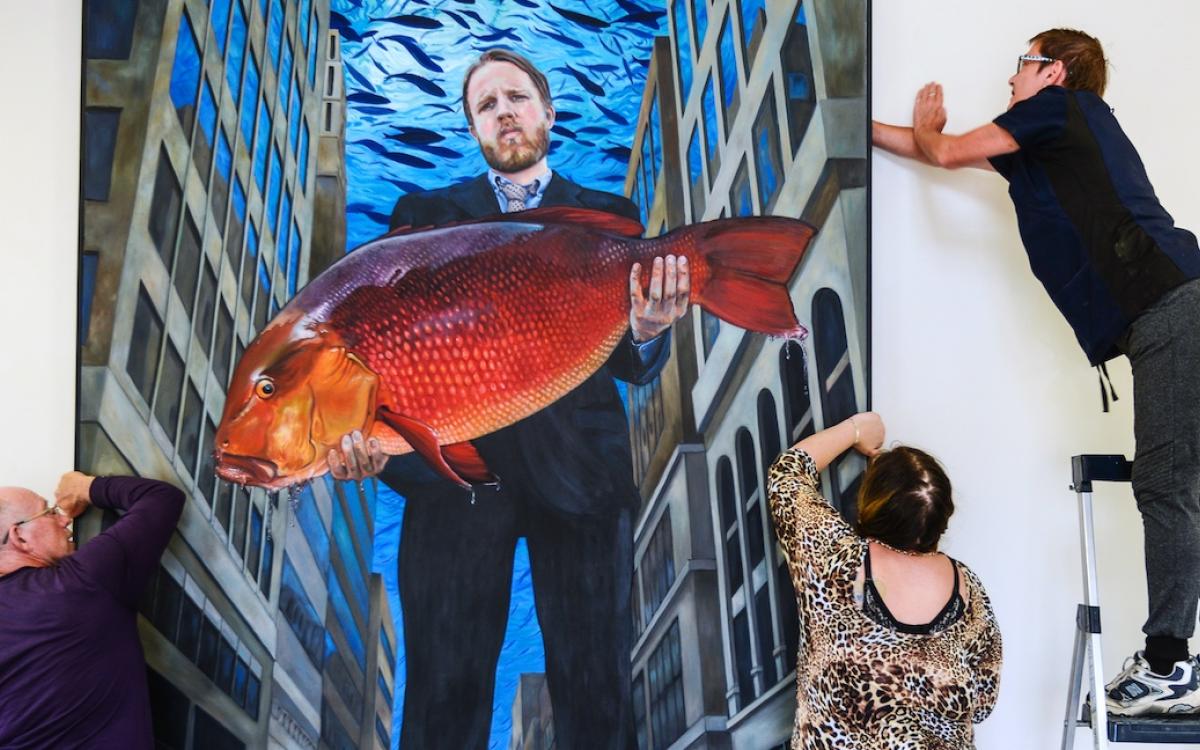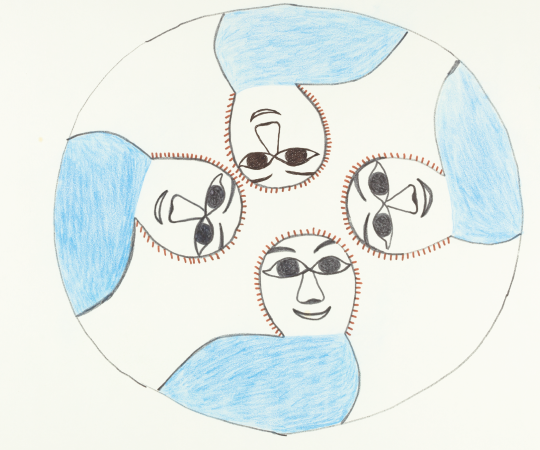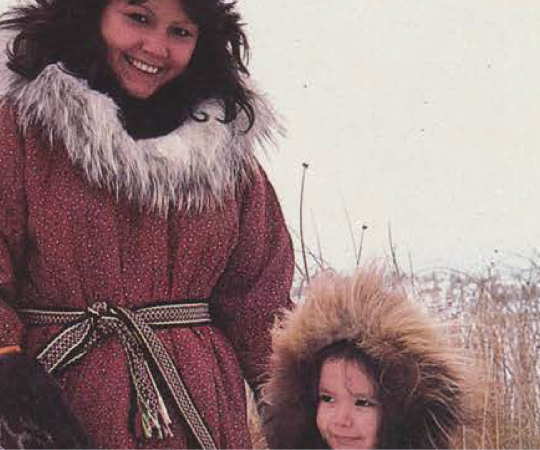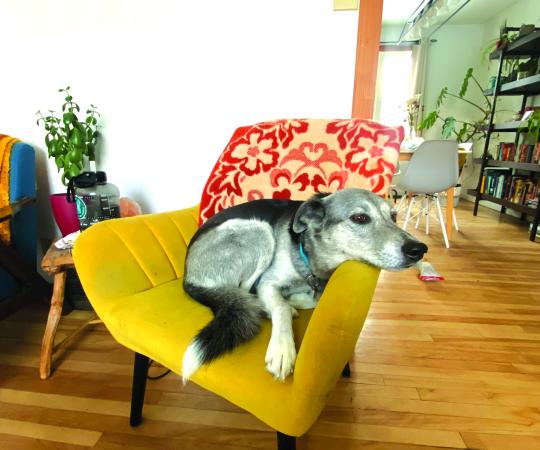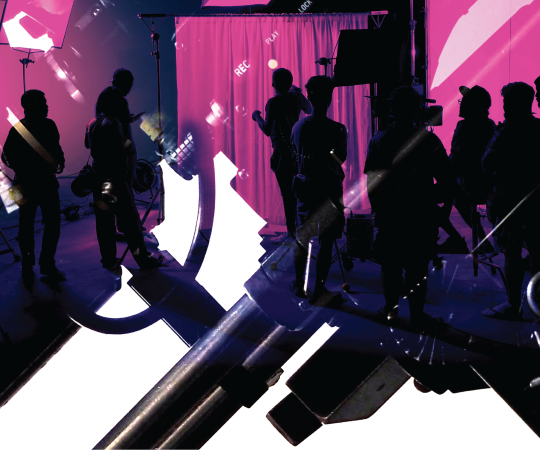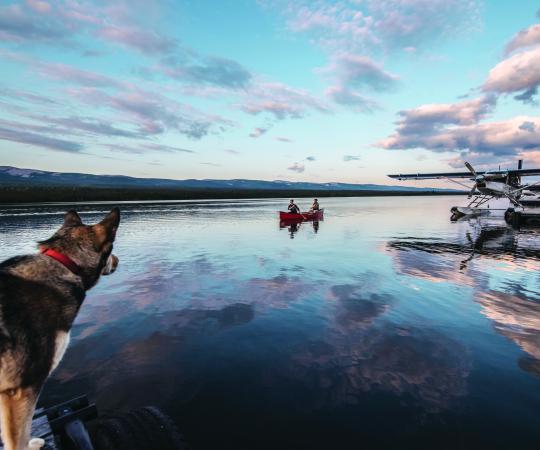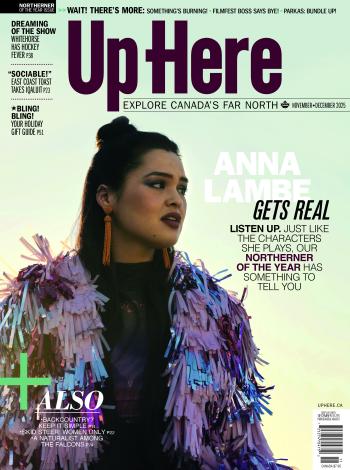A giant bison looms out of the darkness, its eyes glowing. It knows the Vancouver International Film Festival wants to meet it, badly. The bison is part of a collaboration between Yellowknife multimedia artists Casey Koyczan and Travis Mercredi, that will bring NWT myths and legends to life using virtual reality.
Somewhere between a video game and a holodeck, the final piece will include chapters that players can watch and play through.
“We’re really surprised as to how much attention it’s gotten,” says Koyczan. They’d applied to a few festivals, and one of the curators sent their trailer on to the Vancouver International Film Festival. “They contacted us being like, ‘Is it done? Can I see it?’ and we’re just like, ‘uh...no?’”
The piece is planned to be completed this fall, but the interest in northern art isn’t new. Northern art pops up on international branding campaigns, northern musicians are greeted with applause in southern venues, northern-made films win awards at film festivals. Around the world northern images and icons define what it is to be Canadian. Inuksuit, icebergs, snow-covered tundra are all images that leap to mind when Canada declares “We the North.” But now that attention is rapidly increasing.
“We’re feeling that for sure,” says Mary Bradshaw, director of visual arts at the Yukon Arts Centre. “In a lot of ways Canadians define themselves as northern but their actual exposure to northern Canada may be small.”
Almost a decade ago, Bradshaw says the YAC had a travelling exhibit that was a “really hard sell” in southern Canada. “I had an easier time selling it to England, literally overseas was far more interested than the rest of Canada.” Today, a similar exhibition? Totally different story. “I’m having way more pick up. There’s more of an appetite at the moment.”

Maybe it’s the internet bringing artists from far-flung remote parts of the country onto people’s phones and desktops. Maybe it’s the recommendations of the Truth and Reconciliation Commission that highlighted art as a way to move forward. Maybe it’s just the right time. Whatever it is, one thing is clear: northern art is so hot right now. But how much does southern Canada actually support northern art’s creation?
In the National Gallery of Canada’s collection of some 78,000 works, there are 1,719 pieces of art made by 511 Inuit artists. From the Yukon, there are four artists and 15 pieces. The gallery doesn’t break up collections by geography (although they do have an Indigenous and Inuit collections area), so comparisons are difficult between the territories and the provinces. In fact, gathering data at all is difficult for the arts: even Statistics Canada often doesn’t include the territories in their surveys of Canada’s artistic landscape—whether it’s the difficulty of geography in obtaining statistics, or the smaller population making the territories statistically unimportant, many data sets that explain the impact and interest in Canadian art simply do not include the North. And yet, the 2010 Vancouver Olympics used an inuksuk as its emblem. A polar bear graces our toonie. And the banner images on Destination Canada’s tourism website features caribou crossing the treeline and visitors snowshoeing across a frozen Arctic lake.
There’s no question northern art is big money, but not always for northern artists. One of the pieces held by the National Gallery is Kenojuak Ashevak’s The Enchanted Owl, one of the most recognizable pieces of Canadian art worldwide. In 2018, a copy of the 1960 print sold for $216,000: the highest amount paid for a Canadian artist at auction. It was originally sold for between $24 and $50, depending who you ask, by the artist, who died in 2013. Because it had already been sold, as CBC reported, Ashevak’s estate did not get any of the profits from the record-breaking sale. Parliament has discussed this very issue several times over the last decade, most recently in June when a review of Canada’s Copyright Act looked at a number of updates, including adding an artist resale right creating royalty payments of five per cent of the sale price whenever a piece of their artwork is sold at auction or through a gallery. Such a change could have a real impact on northern artists, especially First Nations and Inuit. But it also faces a number of constitutional and logistical challenges. The Government of Canada is now consulting with provincial and territorial governments, Indigenous groups, and other stakeholders to report back on the matter in three years.
Commercial sales aside, there is limited space to show or perform northern art in the North. The Yukon has, by far, the most gallery and performance space, with the Yukon Arts Centre and several gallery spaces. The NWT has the Northern Arts and Culture Centre, a theatre attached to a high school, and the Prince of Wales Northern Heritage Centre—but no public gallery for artists to display their work, let alone a contemporary gallery. Nunavut, meanwhile, is the only part of Canada with no performing arts center. As for gallery space, many northern artists make do with temporary galleries, mobile exhibitions, or displaying small pieces in coffee shops, tourism centers, and other similar venues.
Michelle Emslie, director of programming at the Yukon Arts Centre says the “penny dropped” for her when the National Arts Centre's SCENE series highlighted the North. The series of biennial festivals showcased artists from every region of Canada, starting in 2003 with Atlantic Canada and working their way across the country. In 2013, it was the North’s turn.
“There was a feeling that we didn’t have the star power that provinces did, and so the venues that were booked were smaller,” says Emslie. “But when all the Northerners were in Ottawa and we took over, everything was packed. It really speaks to the interest that Canadians have for the North, or even internationally now.”

Giving people a real glimpse of the modern Canadian Arctic is something Jocelyn Piirainen thinks art has the power to do. She’s the assistant curator of Inuit art at the Winnipeg Art Gallery, where next year the Inuit Art Centre will open its doors to showcase the more than 13,000 pieces of Inuit art held by the gallery—some of it in trust for the government of Nunavut, as there currently is no appropriate gallery space in Nunavut. It’s a monumental undertaking; a one of a kind example of showcasing and celebrating northern art, under the curatorship of an Inuit professional—but it’s still in Winnipeg, not Iqaluit. Piirainen’s originally from the North, and lived in Cambridge Bay before heading south. She sees a lot of northern art.
“The content really is reflecting the kind of contemporary lifestyles of Inuit or Indigenous artists living in the North. There are some of the public that are still very much surprised by this contemporary view of the North. It’s a great thing for southern audiences to see that. For them to change their own perspectives on what the North is. We’re not all living in iglus anymore. The North is a modern, contemporary place and we’re trying to merge the contemporary and the traditional as well.”
Whether that will mean Canada’s brand is expanding beyond inuksuit and polar bears remains to be seen. But she’s hoping the current attention on northern art will go beyond the stereotypical images. The very first exhibit at the new museum will focus on contemporary Inuit art that’s been produced within the last two decades. It will feature everything from prints, drawings and carvings to short films, and crafts like parkas and examples of current fashion design.
“If people tend to focus on the polar bears and the inuksuit they’re not seeing the full range of what Inuit or Indigenous art is,” Piirainen says. “Even I have to remind myself too that the North is not just a focus on Inuit.”
Art can be a window into that world, a way to see what’s really happening in the North—if the rest of the world can look beyond its expectations.

The YouTube video fades up to a girl in a yellow tank top, hoop earrings, and red lipstick. The intro of Havana begins to play. But when Kelly Fraser starts singing, it’s not Camila Cabello’s English lyrics—she’s translated the song into Inuktitut and hits every beat, but in her language. Another video has Fraser singing Diamonds by Rhianna in Inuktitut, spliced with images of the aurora, polar bears on the tundra, and hands with Inuit tattoos.
Fraser has been nominated for a Juno and Indigenous Music Award, and writes her own music covering topics like suicide, food insecurity, and the lasting effects of colonial violence in the North. But she’s also creating covers of popular tunes with disco beats. She doesn’t fit either of the expected molds for a northern musician—neither purely traditional, nor a copy of southern stars. She’s both.
“I face a lot of criticism from my own people about the way I say Inuktitut words or the way I hold myself or the way I sing my songs. The fact I make translations, people have told me ‘so you don’t know how to write your own songs.’ I’ve stopped telling people I’ve just been nominated for an all-original album and most of the music I’ve made is my own, and the covers are fun to keep our language strong. I just let my art explain it,” she says.
The covers are a way to encourage other Inuit to use Inuktitut, but they also brought her attention from around the world. “I don’t understand why Indigenous music isn’t played more in this country. We should all be celebrating Indigenous music,” she says.
That’s something Koyczan, he of the horrifying bison, understands. He says when you think of northern art, one of the first things that pops to mind is Indigenous art—it’s unavoidable, but not uncomplicated.
“It reminds me of a piece I saw at the Kamloops art gallery one year with a show that Tania Willard created. It was this vinyl lettering that said, ‘I’m Indian, that’s why I’m in this show,’ in giant letters. And I think that speaks so much to what has been happening and what is happening right now, this draw towards northern or Indigenous art primarily for the sake that it’s northern and Indigenous art,” he says.
Which isn’t necessarily a bad thing—as long as including Indigenous artists isn’t just checking boxes.
“There is the commodification aspect of it, where galleries and curators are not necessarily required to, but kind of feel obligated to represent Indigenous artists, to tick that box,” he says. “There’s a lot of Indigenous artists who don’t want to be labelled an Indigenous artist—they want to be an artist who just happens to be Indigenous. Being Indigenous or from the North shouldn’t necessarily give you a pass on your credibility or your popularity or how good your art is. It should be your art, and your aesthetic, the concepts you’re bringing to the table, the conversations you’re enabling people to create.”

And that doesn’t have to be pretty, or expected. He’s participated in several international fellowships and collaborations with artists from around the world. When people overseas think of Canadian art, they often think of people doing lovely landscape art, á la the Group of Seven.
“My art is anything but pretty. I make monstrosities, as one of my former classmates said, and I love it! Personally I don’t think that we should be pigeon-holed as being stereotypically viewed as northern artists because of our art. We are able to think so outside the box that people can view it as being like, ‘Whoa this comes from the North? I had no idea.’”
Tokenism concerns aside, interest in northern art may be fueled, at least in part, by the current political climate that’s focusing on Indigenous culture and reconciliation.
“I think it’s maybe a moment of critical mass. This work has existed for a long time, it’s been collected at different institutions for a long time, but it’s now being represented in more places and more often. It’s starting to get a foothold in the public’s brain,” says Greg Hill, Audain senior curator of Indigenous art at the National Gallery of Canada, adding that awareness leads to a desire to see more. In part of the gallery’s efforts to decolonize, it doesn’t separate Indigenous art into its own category.
The current political climate may be turning eyes north, but Koyczan isn’t sure how comfortable he is with opportunities being created because northern art is popular.
“The idea of Indigenous art or northern art being quote-unquote hot right now, it is true to an extent, but I don’t want to admit that because then it just makes it seem like a fad,” he says. “Like, oh, well next year or five years down the road is Indigenous art or northern art going to be excluded from everything because it’s not hot or popular or the trend?”
The solution? Using the current interest to help northern artists at home. That would also keep the economic benefits of the arts in the North as well. The latest data from Statistics Canada found that in 2017, the gross domestic product from culture amounted to $53.1 billion across the country, supporting 666,500 jobs—or 3.6 per cent of all jobs in the Canadian economy. Sound recording, visual, and applied arts all had economic increases in 2017. Across the territories, culture had a 2.1 per cent share of the total GDP in the Yukon, at $1,467 per capita. For Nunavut, culture accounts for 1.7 per cent or $1,285 of total GDP and the NWT it's at 1.6 per cent or $1,716.

“People don’t know that there are a lot of artists making art up here because we don’t have that representation, we don’t have that support, we don’t have that kind of mechanism working for us,” says Koyczan. Both he and Fraser have had to go south to pursue their art—she’s currently based in Ottawa to work as a musician full-time; he just relocated to Winnipeg to pursue further arts education. “There are a lot of organizations that kind of do that or somewhat represent that but it dwarfs in comparison to everywhere else in Canada. That’s why I really value and love doing workshops in the North in remote communities to inspire youth. In the future, you don't have to work in the mines. You can go against the stigma of not being able to make any money as an artist.”
But they might have to venture away from home. Currently, if Northerners want to see northern art, their best bet is to go to the south, where they can see northern scenes held in galleries like the National Gallery or Winnipeg Art Gallery.
“The flow of artwork has been from the north to the south and rarely does it return. And that's an issue, when an artist can be prolific their entire life and never see their work again, unless they're invited south to an opening to see their work in an exhibition,” says Hill.
There's a difference between seeing art in a gallery and seeing it in a museum, even at a special exhibit in the museum. Museums, by their nature, look backwards—they hold that art in stasis; a relic of the past, a culture under glass. Galleries, on the other hand, provide space for artists to innovate, learn from each other, and display large works. Koyczan's known for going big. Very big. One of his first pieces was a hollowed-out log 25 feet wide by 50 feet long by 15 feet high. The installation took up the entirety of the drawing studio where it was displayed and combined with sound and the smell of the wood, was not art you looked at, but art you experienced.
Would that be possible in the staid environment of a museum? And for southern Canadians or people overseas, newly discovering northern art? They can view it, but only in Montreal, Ottawa, Toronto, and Winnipeg, not Yellowknife, Iqaluit, or Whitehorse. And that, for Koyczan, is a missed opportunity nearly as big as the blank walls on the sides of buildings in Yellowknife he's dying to paint with murals.
“If they come up here, what are they going to see? What galleries are they going to visit?” Koyczan wonders. “There is almost no place in Yellowknife for an artist like myself to show their artwork, which is a huge hindrance in getting myself out there or just showing my work.”
If Canada is going to support We The Actual North, and northern artists, everyone agrees: it's time to support northern artists at home.
“These are our stories to tell,” says Piirainen.

